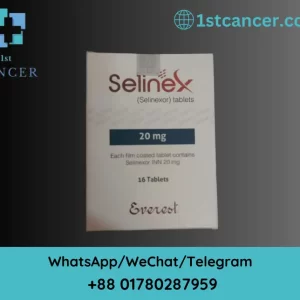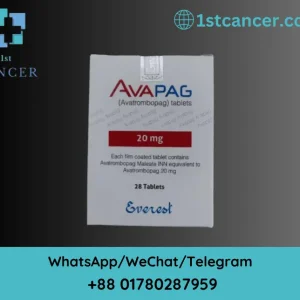Trelagliptin (Wedica) is an oral medication used in the management of type 2 diabetes. Marketed under the brand name Wedica, Trelagliptin is classified as an oral antidiabetic drug belonging to the class of medications known as dipeptidyl peptidase-4 (DPP-4) inhibitors.
Trelagliptin functions by enhancing the levels of incretin hormones in the body. Incretins are responsible for regulating blood sugar by stimulating the release of insulin after meals and by reducing the production of glucagon by the liver.

By inhibiting the DPP-4 enzyme, Trelagliptin prolongs the action of these incretin hormones, which helps lower blood sugar levels in individuals with type 2 diabetes.
Patients prescribed Trelagliptin, sold as Wedica, typically take this medication orally, following the prescribed dosage as directed by their healthcare provider. It’s often used as part of a comprehensive treatment plan for type 2 diabetes, which may include lifestyle modifications, diet, exercise, and other antidiabetic medications.
Common side effects associated with Trelagliptin might include headaches, upper respiratory tract infections, and gastrointestinal disturbances, although the side effects and their severity can vary among individuals.
Trelagliptin, marketed as Wedica, offers an additional option for the management of type 2 diabetes, contributing to the armamentarium of available medications aimed at controlling blood sugar levels. As with any prescribed medication, its use, dosage, and potential side effects should be discussed and monitored under the guidance of a healthcare professional.
Introduction of Trelagliptin (Wedica):
In the dynamic landscape of diabetes management, where precision and efficacy are paramount, Trelagliptin emerges as a promising agent, offering a fresh perspective on glycemic control. As a member of the dipeptidyl peptidase-4 (DPP-4) inhibitor class, Trelagliptin stands at the forefront of innovations in antidiabetic therapies. This introduction navigates the contours of Trelagliptin, exploring its pharmacological intricacies, clinical relevance, and its potential to reshape the narrative of diabetes care.
*1. Understanding the DPP-4 Inhibition Mechanism:
- Trelagliptin, like other DPP-4 inhibitors, operates by targeting dipeptidyl peptidase-4, an enzyme responsible for the rapid degradation of incretin hormones. Incretins, such as glucagon-like peptide-1 (GLP-1) and glucose-dependent insulinotropic polypeptide (GIP), play pivotal roles in glucose homeostasis. By inhibiting DPP-4, Trelagliptin prolongs the action of incretins, promoting insulin release and suppressing glucagon secretion in a glucose-dependent manner.
*2. Pharmacokinetic Distinctiveness:
- What sets Trelagliptin apart is its unique pharmacokinetic profile. Characterized by an extended half-life, Trelagliptin offers the convenience of once-weekly dosing, providing a practical solution to enhance patient adherence and streamline the management of Type 2 diabetes mellitus (T2DM). This distinctive feature contributes to its appeal as a therapeutic option in the diverse landscape of antidiabetic medications.
*3. Clinical Significance in Type 2 Diabetes Mellitus (T2DM):
- Trelagliptin’s clinical significance manifests in its effectiveness in T2DM management. By modulating incretin hormone activity, Trelagliptin assists in glycemic control, particularly after meals when glucose levels tend to rise. Clinical trials have demonstrated its ability to reduce hemoglobin A1c levels, making it a valuable addition to the armamentarium for T2DM treatment.
*4. Patient-Centric Approach:
- Beyond its pharmacological efficacy, Trelagliptin embodies a patient-centric approach. The convenience of weekly dosing aligns with the growing emphasis on enhancing patient adherence and minimizing the burden of daily medication regimens. Trelagliptin’s user-friendly dosing schedule contributes to the holistic goal of optimizing patient outcomes and overall well-being.
*5. Safety Profile and Tolerability:
- Trelagliptin’s safety profile and tolerability are essential considerations in its clinical utility. As with any medication, understanding its side effect profile, potential interactions, and the context of individual patient health is crucial. Trelagliptin’s journey involves a careful evaluation of its benefits against potential risks, ensuring a balanced and informed approach to its prescription.
*6. Emerging Trends and Ongoing Research:
- The introduction of Trelagliptin also prompts exploration into emerging trends and ongoing research initiatives. As the scientific community delves deeper into diabetes pathophysiology, Trelagliptin’s role may expand, and its potential applications in specific patient populations or novel therapeutic combinations could shape the future landscape of diabetes care.
As we embark on this exploration of Trelagliptin, its introduction marks a milestone in the continual evolution of diabetes management. The unique features of Trelagliptin, from its extended half-life to its patient-centric dosing, underscore its potential to bring about positive shifts in the paradigm of diabetes care. This introduction serves as a gateway to unravel the multifaceted dimensions of Trelagliptin, inviting a closer examination of its pharmacological prowess and its role in shaping a future where precision and patient well-being intersect in the realm of diabetes therapeutics.
Background of Trelagliptin (Wedica):
The background of Trelagliptin encompasses a journey that intertwines scientific discovery, pharmacological innovation, and a steadfast commitment to advancing diabetes management. As a member of the dipeptidyl peptidase-4 (DPP-4) inhibitor class, Trelagliptin (Wedica) has evolved against the backdrop of a growing understanding of diabetes pathophysiology and the continuous quest for effective and patient-friendly antidiabetic therapies.
*1. The Rise of DPP-4 Inhibitors:
- The roots of Trelagliptin are firmly embedded in the broader emergence of DPP-4 inhibitors as a distinct class of antidiabetic agents. The concept of targeting DPP-4 to modulate incretin hormones, particularly glucagon-like peptide-1 (GLP-1) and glucose-dependent insulinotropic polypeptide (GIP), gained prominence as researchers sought strategies to enhance glycemic control in Type 2 diabetes mellitus (T2DM).
*2. Incretin Hormones and Glucose Homeostasis:
- Central to the development of Trelagliptin (Wedica) is the understanding of incretin hormones and their pivotal role in glucose homeostasis. Incretins stimulate insulin secretion and inhibit glucagon release in response to elevated blood glucose levels, exerting a glucose-dependent effect. DPP-4, the enzyme targeted by Trelagliptin, rapidly degrades these incretins, and inhibiting DPP-4 prolongs their action.
*3. Trelagliptin’s Unique Pharmacokinetics:
- Trelagliptin distinguishes itself with a unique pharmacokinetic profile. Its extended half-life facilitates once-weekly dosing, offering a departure from the daily regimens characteristic of some antidiabetic medications. This distinctive feature is not only pharmacologically relevant but also addresses a practical aspect of patient adherence, a critical component in achieving successful diabetes management.
*4. Clinical Development and Regulatory Approvals:
- The background of Trelagliptin (Wedica) is marked by a rigorous journey through clinical development and regulatory evaluations. Clinical trials assessed its safety, efficacy, and impact on glycemic control in individuals with T2DM. Regulatory approvals underscored its readiness to contribute to the diverse array of treatment options available to healthcare providers managing diabetes.
*5. Efficacy in Glycemic Control:
- Trelagliptin’s background story unfolds with a focus on its efficacy in glycemic control. Clinical studies have demonstrated its ability to reduce hemoglobin A1c levels, providing tangible evidence of its impact on long-term glucose regulation. This efficacy contributes to its role as a valuable addition to the therapeutic arsenal in T2DM management.
*6. Patient-Centric Considerations:
- Trelagliptin’s evolution takes into account the growing emphasis on patient-centric care. The convenience of weekly dosing aligns with the broader goal of enhancing patient adherence and minimizing the daily burden associated with managing chronic conditions. Trelagliptin’s background is, in part, shaped by a commitment to optimizing the overall patient experience in diabetes care.
*7. Ongoing Research and Future Directions:
- As Trelagliptin takes its place in the armamentarium of antidiabetic medications, ongoing research initiatives contribute to its evolving background. Explorations into potential applications in specific patient populations, combination therapies, and novel formulations signal a future where Trelagliptin’s role may continue to expand, offering new dimensions in the management of diabetes.
In tracing the background of Trelagliptin (Wedica), one unravels a narrative of scientific inquiry, clinical advancement, and a dedication to improving the lives of individuals living with diabetes. Its journey reflects the collaborative efforts of researchers, healthcare providers, and pharmaceutical innovators, converging toward the common goal of advancing diabetes care through precision and patient-centricity.





